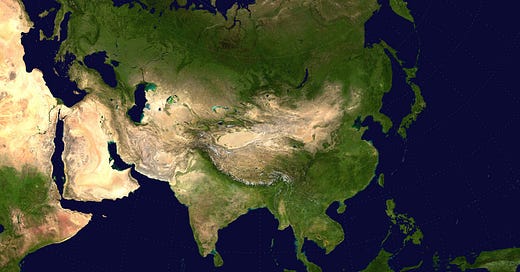Eurasia note #43 - China and Israel, The New Silk Road
The Ukraine war is one more step on the path to reshaping the trade blocs
Eight-mile Russian convoy readies for assault on Donbas — Pentagon.
U.S. sends $800 mn weaponry including Mi-17 helicopters and missiles.
Sweden and Finland may join NATO as early as this summer, says Times newspaper.
Russia would take defensive measures along 1,300 km Finnish border.
Russia claims it killed Right Sector nationalist Taras Bobanich.
Société Générale ceases banking and insurance activities in Russia.
Pentagon hosts eight biggest US weapons manufacturers to step up production.
Regime change extends from Pakistan to potentially the heart of the European Union.
(2,900 words or about 14 minutes’ read.)
Tbilisi, Apr 14, 2022
Why did the European Union and NATO talk for aeons about energy security, yet when push came to shove, produce little but hot air?
While leaving themselves short, the Atlanticists pushed Russia closer to China. This is nothing new — Beijing and Moscow were discussing long-term contracts a decade ago — but the risk of creating a rival Eurasian trading bloc should have been obvious.
And by advancing aggressively on Russia’s borders, why was NATO content to give Russia the impression that it might itself be attacked?
In this article we’ll compare and contrast China’s approach, and ask if we witness more than chess moves on the Eurasian board or perhaps a clash of cultures that goes deeper than war and business.
As we scale the higher slopes of the corporate mountain, the owners and investors no longer see national borders but only resources and syndicates. Once we reach the summit, corporations shall have established a total hegemony which one can glimpse between the lines of Klaus Schwab’s The Great Reset.
The press does not help. Information is not objective for it requires interpretation that is more commonly today replaced by emotion. We conclude those who control the media seek to manage outcomes. And if the owners don't, there plenty of lobbyists who'll do it for them.
The network of interest groups is much more complex than the media portrays on questions like the war in Ukraine, Russia’s responsibility, the accidental vacuum in Afghanistan, the ousting of Pakistan’s premier, and the food riots that have begun in Sri Lanka and Peru and are likely to spread to Western capitals.
A single theme cannot suffice for fast-moving events with many variables. Some have gained prominence — the end of the petrodollar, for example — while commentators have latched onto Brzezinski or before him to Mackinder’s heartland theory.
Of ships and sealing wax
We’re witness to something bigger than a battle for Eurasia and its resources; not least because the trade and economic tendrils reach far beyond the bloodlands.
Some see the World Economic Forum as the voice of Europe’s bankers and aristocrats, a subsidiary of the Bilderberg group, or simply what the WEF says it is: an influence peddler for the top 1,000 corporations. Others mull why the Trilateral Commission should have ceded the spotlight to Schwab’s shiny pate.
Others focus on the playing field where these groups let fly their rivaly: the tug-of-war between the central banks of the U.S. and Europe; the shot put and javelin with which European leaders seek to pin or floor their rivals; or the kayaks in which they dream schoolboy fantasies of triremes reconquering lost lands.
Their classical education cannot help these elites. The sun does not obey. As he glowers in a gunmetal sky, stubborn Helios hoards his warmth for an eastern dawn. Gravely he tamps down their ambition and, flaring, lights new fires in another cline.
And so we see Europe’s aristocratic dream of relaunching its influence upon the world and culture confined to port. It can’t decide upon a route, its broad union hobbled financially; unable to reconstitute as one around a northern axis; while the good ship Deutschland struggles to free itself of U.S. hawsers.
We know the map is not so stark as when the British painted it one-quarter red.
Each team has outposts in its corner. The Europeans and Americans still reach to old Canton, the Chinese Communist Party owns its placemen in Washington, and the City of London has fingers in more pies than there are blackbirds.
The British have been deep in China since the first opium war in the 1830s, and there is still a British, American and Jewish familial link to Harbin in the north and the southern port cities. Likewise as there are many American families who owe their wealth to the opium trade: Delano, Astor, Weld, Cabot, Cushing, Forbes, Lowell, Kirkland, Perkins, Coolidge, Jefferson, Kerry, Russell and Green — Skull and Bones and all the top university endowments which were deep in opium and China.
We have to move beyond views deriving from 200 years of Western imperial meddling in Russia, and the concepts rooted in the 19th century of the battle for control of Eurasia. Sometimes we need a little less geopolitics and Halford Mackinder and a bit more bizniz.
But what about more modern trade alliances, such as that with Israel? Given its geographic location on the new water-bourne and cyber Silk Road, what is the outlook?
New kid on the bloc
China’s rapid industrial transformation requires that it constantly expand its markets, but first find new energy sources, logistics and warehouses, and — as wage costs climb — even new sources of labour.
But what if the new trade routes are not only physical — what then will be the answer? In a world of cybernetic governance, which commercial allies are better placed than Israel on the one hand, and Russia on the other?
Keep reading with a 7-day free trial
Subscribe to Moneycircus to keep reading this post and get 7 days of free access to the full post archives.



